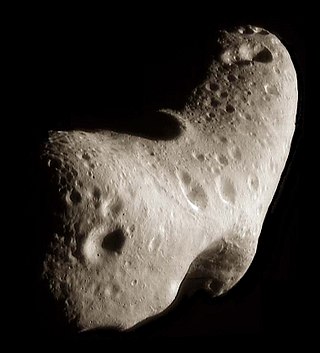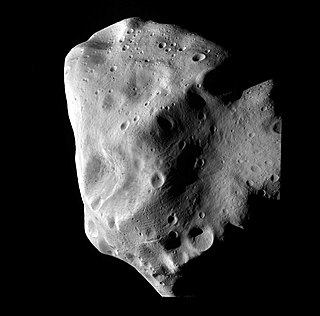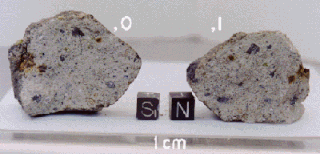
Vesta is one of the largest objects in the asteroid belt, with a mean diameter of 525 kilometres (326 mi). It was discovered by the German astronomer Heinrich Wilhelm Matthias Olbers on 29 March 1807 and is named after Vesta, the virgin goddess of home and hearth from Roman mythology.

Pallas is the second asteroid to have been discovered, after Ceres. It is believed to have a mineral composition similar to carbonaceous chondrite meteorites, like Ceres, though significantly less hydrated than Ceres. It is the third-largest asteroid in the Solar System by both volume and mass, and is a likely remnant protoplanet. It is 79% the mass of Vesta and 22% the mass of Ceres, constituting an estimated 7% of the mass of the asteroid belt. Its estimated volume is equivalent to a sphere 507 to 515 kilometers in diameter, 90–95% the volume of Vesta.

The asteroid belt is a torus-shaped region in the Solar System, centered on the Sun and roughly spanning the space between the orbits of the planets Jupiter and Mars. It contains a great many solid, irregularly shaped bodies called asteroids or minor planets. The identified objects are of many sizes, but much smaller than planets, and, on average, are about one million kilometers apart. This asteroid belt is also called the main asteroid belt or main belt to distinguish it from other asteroid populations in the Solar System.
A V-type asteroid or Vestoid is an asteroid whose spectral type is that of 4 Vesta. Approximately 6% of main-belt asteroids are vestoids, with Vesta being by far the largest of them. They are relatively bright, and rather similar to the more common S-type asteroid, which are also made up of stony irons and ordinary chondrites, with V-types containing more pyroxene than S-types.

S-type asteroids are asteroids with a spectral type that is indicative of a siliceous mineralogical composition, hence the name. They have relatively high density. Approximately 17% of asteroids are of this type, making it the second-most common after the carbonaceous C-type.

C-typeasteroids are the most common variety, forming around 75% of known asteroids. They are volatile-rich and distinguished by a very low albedo because their composition includes a large amount of carbon, in addition to rocks and minerals. They have an average density of about 1.7 g/cm3.

M-type asteroids are a spectral class of asteroids which appear to contain higher concentrations of metal phases than other asteroid classes, and are widely thought to be the source of iron meteorites.
T-type asteroids are rare inner-belt asteroids of unknown composition with dark, featureless and moderately red spectra, and a moderate absorption feature shortwards of 0.85 μm. No direct meteorite analog has been found to date. Thought to be anhydrous, they are considered to be related to P-types or D-types, or possibly a highly altered C-type.
P-type asteroids are asteroids that have low albedo and a featureless reddish spectrum. It has been suggested that they have a composition of organic rich silicates, carbon and anhydrous silicates, possibly with water ice in their interior. P-type asteroids are found in the outer asteroid belt and beyond. There are in the neighborhood of 33 known P-type asteroids, depending on the classification, including 46 Hestia, 65 Cybele, 76 Freia, 87 Sylvia, 153 Hilda, 476 Hedwig and, in some classifications, 107 Camilla.

Hebe is a large main-belt asteroid, containing around 0.5% of the mass of the belt. However, due to its apparently high bulk density, Hebe does not rank among the top twenty asteroids by volume. This high bulk density suggests an extremely solid body that has not been impacted by collisions, which is not typical of asteroids of its size – they tend to be loosely-bound rubble piles.

An achondrite is a stony meteorite that does not contain chondrules. It consists of material similar to terrestrial basalts or plutonic rocks and has been differentiated and reprocessed to a lesser or greater degree due to melting and recrystallization on or within meteorite parent bodies. As a result, achondrites have distinct textures and mineralogies indicative of igneous processes.
The Vesta family is a family of asteroids. The cratering family is located in the inner asteroid belt in the vicinity of its namesake and principal body, 4 Vesta. It is one of the largest asteroid families with more than 15,000 known members and consists of mostly bright V-type asteroids, so-called "vestoids".

An asteroid spectral type is assigned to asteroids based on their reflectance spectrum, color, and sometimes albedo. These types are thought to correspond to an asteroid's surface composition. For small bodies that are not internally differentiated, the surface and internal compositions are presumably similar, while large bodies such as Ceres and Vesta are known to have internal structure. Over the years, there has been a number of surveys that resulted in a set of different taxonomic systems such as the Tholen, SMASS and Bus–DeMeo classifications.
The X-group of asteroids collects together several types with similar spectra, but probably quite different compositions.
The rare O-type asteroids have spectra similar to the unusual asteroid 3628 Boznemcová, which is the best asteroid match to the spectra of L6 and LL6 ordinary chondrite meteorites. Their spectra have a deep absorption feature longward of 0.75 μm.

HED meteorites are a clan (subgroup) of achondrite meteorites. HED stands for "howardite–eucrite–diogenite". These achondrites came from a differentiated parent body and experienced extensive igneous processing not much different from the magmatic rocks found on Earth and for this reason they closely resemble terrestrial igneous rocks.

Eucrites are achondritic stony meteorites, many of which originate from the surface of the asteroid 4 Vesta and are part of the HED meteorite clan. They are the most common achondrite group with over 100 meteorites found.

Angrites are a rare group of achondrites consisting mostly of Al-Ti bearing diopside, hedenbergite, olivine, anorthite and troilite with minor traces of phosphate and metals. The group is named for the Angra dos Reis meteorite. They are the oldest igneous rocks, with crystallization ages of around 4.56 billion years. Angrites are subdivided into two main groups, the quenched and plutonic angrites. The quenched angrites cooled rapidly upon the surface of the angrite parent body (APB), whereas the plutonic angrites cooled slower, deeper in the crust. The APB is thought to have been a similar size to the asteroid 4 Vesta.
In meteoritics, a parent body is the celestial body from which originates a meteorite or a class of meteorites.
This is a glossary of terms used in meteoritics, the science of meteorites.











